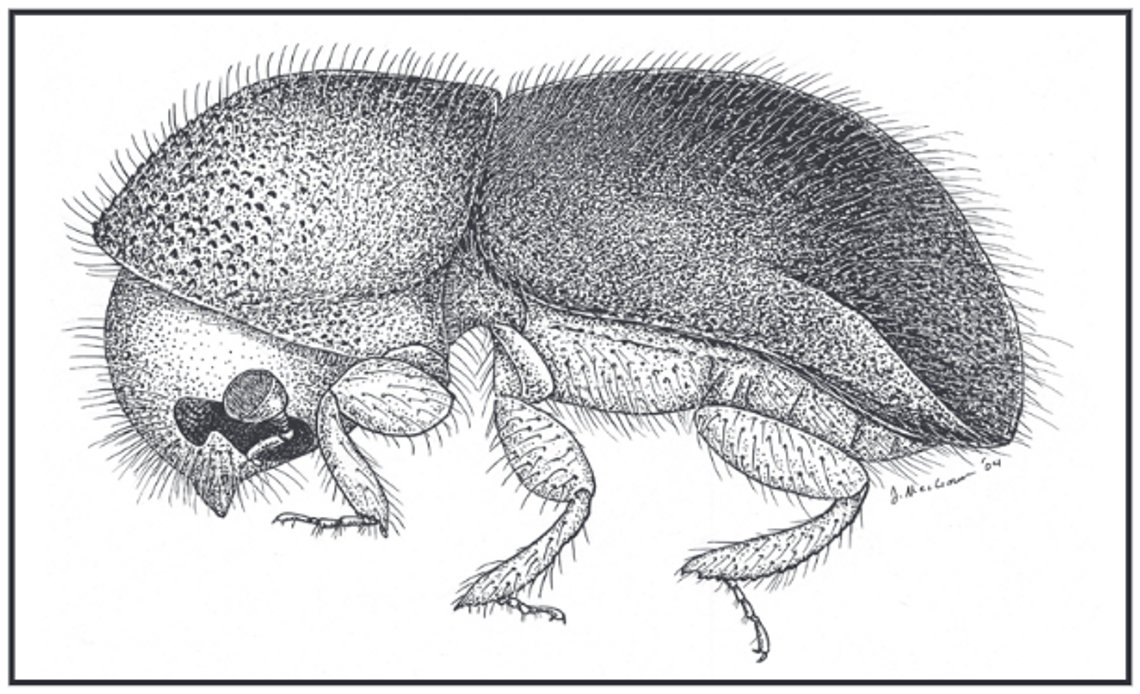The summer before last, I was called to look at five dead mature Sassafras Trees in a yard. Upon arriving, we discovered what looked like toothpicks growing out of the trunk of the dead trees. The toothpicks were columns of compacted saw dust that was forced out by Granulate Ambrosia Beetles, as they bored into the trees.
The Granulate Ambrosia Beetle (GAB), is one of the most damaging insect pests of young trees in Mississippi landscapes, nurseries, and fruit orchards. Most of the damage will occur in the early spring, just before or when the trees are leafing out. A homeowner may notice that the Japanese Maple they planted two years ago does not leaf out in the spring. A commercial nursey may notice a 10% to 15% mortality rate in a couple of different species of their container-grown hardwood saplings.
The non-native GAB was first detected in the U.S. in 1974, and it is now established throughout our state. We have a lot of wood-boring beetles in the state. The GAB is one of the most destructive because the trees attached by it usually dies. It also does not take many GABs to kill a tree. Like most tree borers, the GAB is attracted to stressed or injured trees, as well as newly cut wood, but they will also attack healthy trees, especially trees less than 3 inches in diameter. Unfortunately, these attacks are unusually fatal, because the beetle inoculates its galleries with a fungal disease, which grows within the tree and provides food for the larvae.
An adult female GAB is about 1/10 of an inch long, reddish brown in color, and their heads are bent downward, so the head is not visible when the insect is viewed directly from above. These insects are very difficult to find and identify, but trees being attacked by the GAB are easy to spot because of the toothpick-sized sticks of tightly packed saw dust that are projecting from the tree. These frass sticks are one of the more distinctive symptoms of a GAB attack. These sticks may be straight or curved downward, and they may be up to three inches long. In time, rain and wind will break these off, leaving only birdshot-sized holes.
The GAB attacks many different species of hardwood trees, but it seems to be fond of species that are relatively smooth-barked, especially if they are growing in containers or have been recently transplanted. Some of the species we see attacked by GAB most often are: Bradford Pear, fig, crape myrtle, maple, sweet gum, magnolia, pecan, peach, ornamental cherries, and sometimes woody vines like muscadine and shrubs like azalea. There are more than 100 other documented hosts. The GAB does not attack conifers.
Steps to prevent or control the GAB include keeping trees healthy and free of stress. This helps even though the GAB will successfully attack and kill "apparently healthy" trees. It seems newly transported trees in landscapes, containerized plants growing in nurseries, and fruit trees that have been recently pruned or stressed are some of the most common victims of GAB.
Homeowners shouldn’t be too hasty to remove trees that are already under attack from the GAB. It would make sense to get rid of these, either by burning or in some way removing these trees. Trees that are under attack are highly attractive to other GABs in the area. GABs will usually come to a tree that is already under attack, rather than going to a nearby uninfested tree. Just be sure to cut and destroy the infested tree before the beetle has time to complete their life cycle, which usually last around 55 days.
Preventive insecticide treatments can be applied to the trunks and large limbs of susceptible trees. The objective is to provide an insect barrier on the bark that kills the beetles before they are able to bore into the wood and deposit eggs. No insecticide treatment will kill beetles that have already bored into the trunk.
The problem with preventive treatments is that GAB outbreaks are sporadic. You may have damage one year and very little or none the next year. Also, spring flight times of the GAB may vary from one year to the next.
Source: MSU-ES Bug Wise, No. 1, January 2012



Comment
Comments